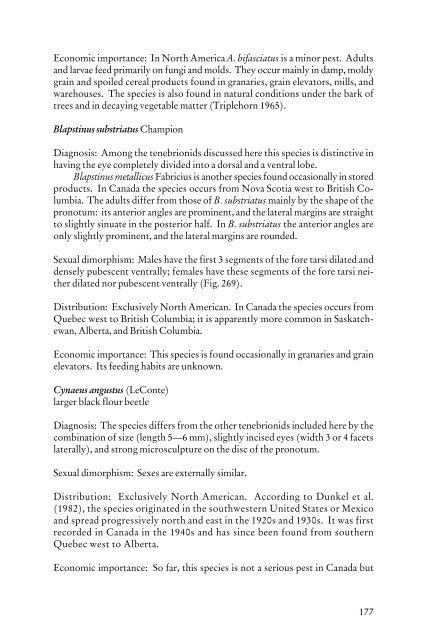Beetles Identification Guide
Beetles Identification Guide
Beetles Identification Guide
Create successful ePaper yourself
Turn your PDF publications into a flip-book with our unique Google optimized e-Paper software.
Economic importance: In North America A. bifasciatus is a minor pest. Adults<br />
and larvae feed primarily on fungi and molds. They occur mainly in damp, moldy<br />
grain and spoiled cereal products found in granaries, grain elevators, mills, and<br />
warehouses. The species is also found in natural conditions under the bark of<br />
trees and in decaying vegetable matter (Triplehorn 1965).<br />
Blapstinus substriatus Champion<br />
Diagnosis: Among the tenebrionids discussed here this species is distinctive in<br />
having the eye completely divided into a dorsal and a ventral lobe.<br />
Blapstinus metallicus Fabricius is another species found occasionally in stored<br />
products. In Canada the species occurs from Nova Scotia west to British Columbia.<br />
The adults differ from those of B. substriatus mainly by the shape of the<br />
pronotum: its anterior angles are prominent, and the lateral margins are straight<br />
to slightly sinuate in the posterior half. In B. substriatus the anterior angles are<br />
only slightly prominent, and the lateral margins are rounded.<br />
Sexual dimorphism: Males have the first 3 segments of the fore tarsi dilated and<br />
densely pubescent ventrally; females have these segments of the fore tarsi neither<br />
dilated nor pubescent ventrally (Fig. 269).<br />
Distribution: Exclusively North American. In Canada the species occurs from<br />
Quebec west to British Columbia; it is apparently more common in Saskatchewan,<br />
Alberta, and British Columbia.<br />
Economic importance: This species is found occasionally in granaries and grain<br />
elevators. Its feeding habits are unknown.<br />
Cynaeus angustus (LeConte)<br />
larger black flour beetle<br />
Diagnosis: The species differs from the other tenebrionids included here by the<br />
combination of size (length 5—6 mm), slightly incised eyes (width 3 or 4 facets<br />
laterally), and strong microsculpture on the disc of the pronotum.<br />
Sexual dimorphism: Sexes are externally similar.<br />
Distribution: Exclusively North American. According to Dunkel et al.<br />
(1982), the species originated in the southwestern United States or Mexico<br />
and spread progressively north and east in the 1920s and 1930s. It was first<br />
recorded in Canada in the 1940s and has since been found from southern<br />
Quebec west to Alberta.<br />
Economic importance: So far, this species is not a serious pest in Canada but<br />
177
















